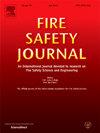Predicting the transient burning of non-charring materials using physics-informed neural networks
IF 3.4
3区 工程技术
Q2 ENGINEERING, CIVIL
引用次数: 0
Abstract
This paper explores the application of Physics-Informed Neural Networks (PINNs) for predicting transient burning rates in Non-Charring materials. By integrating physical principles with deep learning models, PINNs provide an efficient solution, requiring significantly fewer data points compared to traditional numerical methods. For instance, solving the problem numerically with 2000 spatial mesh points would require approximately 131 million data points, whereas the PINNs model used in this study reduced the data points to less than 60,000, while maintaining less than 2 % error in predictive accuracy. The results demonstrate that PINNs can effectively capture transient phenomena, such as burning rate overshoot and undershoot caused by abrupt changes in convective heat flux, offering critical insights into the behavior of materials under varying thermal conditions. The study also highlights opportunities for further improvements in model accuracy and stability, particularly in cases with sparse or noisy data. This methodology holds potential for broader applications, including pyrolysis analysis, combustion processes, and fluid dynamics, showcasing the flexibility and computational efficiency of PINNs in addressing complex dynamic problems.
利用物理信息神经网络预测非炭化材料的瞬态燃烧
本文探讨了物理信息神经网络(PINNs)在非炭化材料瞬态燃烧速率预测中的应用。通过将物理原理与深度学习模型相结合,pinn提供了有效的解决方案,与传统的数值方法相比,需要的数据点要少得多。例如,用2000个空间网格点在数字上解决问题将需要大约1.31亿个数据点,而本研究中使用的PINNs模型将数据点减少到不到6万个数据点,同时在预测精度上保持不到2%的误差。结果表明,pinn可以有效地捕捉瞬态现象,如由对流热通量突变引起的燃烧速率超调和欠调,为了解材料在不同热条件下的行为提供了重要的见解。该研究还强调了进一步提高模型准确性和稳定性的机会,特别是在数据稀疏或有噪声的情况下。这种方法具有更广泛的应用潜力,包括热解分析、燃烧过程和流体动力学,展示了pinn在解决复杂动态问题方面的灵活性和计算效率。
本文章由计算机程序翻译,如有差异,请以英文原文为准。
求助全文
约1分钟内获得全文
求助全文
来源期刊

Fire Safety Journal
工程技术-材料科学:综合
CiteScore
5.70
自引率
9.70%
发文量
153
审稿时长
60 days
期刊介绍:
Fire Safety Journal is the leading publication dealing with all aspects of fire safety engineering. Its scope is purposefully wide, as it is deemed important to encourage papers from all sources within this multidisciplinary subject, thus providing a forum for its further development as a distinct engineering discipline. This is an essential step towards gaining a status equal to that enjoyed by the other engineering disciplines.
 求助内容:
求助内容: 应助结果提醒方式:
应助结果提醒方式:


